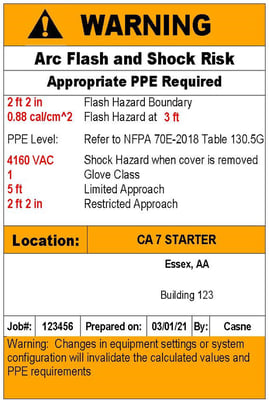In our last post, we discussed the importance of facilities completing an Arc Flash Analysis every five years and after major electrical projects. Now that you are ready to select your partner in an Arc Flash Analysis, let’s discuss your options.
It is important to consider how the partner you choose will support the compliance process. Sometimes the wrong choice can result in unexpected labor and material costs. Knowing exactly what you are getting with the organization you choose is critical and asking the right questions to determine the best partner can help you fulfill your responsibilities in this process.
There are three important questions you should be asking: Who will be responsible for the field investigation and data collection? Who maintains control of the model? Who is responsible for creating, applying, and updating equipment labels?
Who will be responsible for the field investigation and data collection?

Typically, when vendors are left in charge, all the responsibility, risks and costs of data collection required to complete the calculations falls on the shoulders of the client. The vendor’s role in this case is to perform the calculations. If information is missing, it can become a back and forth process to obtain what is needed for an accurate result. Depending on the in-house staff of the client, this may involve additional costs such as an electrician to conduct multiple site visits to find the missing information as it is requested. Vendors may be experts in their products, but they do not necessarily take a holistic approach to your facility. In addition, the electricians hired may have the ability to collect the information requested, but not the expertise to be aware of everything that actually needs to be gathered. The client is then forced to become a go-between in this communication process.
When clients hire a consultant, they can trust that the consultant will handle the onsite investigation and data collection (possibly in conjunction with an electrician). When determining your partner for an Arc Flash Analysis, a consultant who already has had their “boots on the ground” and knows your facility, systems, operations and data becomes a prime choice. Since this type of consultant has been involved in maintaining and upgrading the facilities, their familiarity with your system is key to an efficient process and accurate results. At the end of the day, a consultant with expertise on your specific system, utilizing a holistic approach allows them to not just calculate the data, but to ensure the “model” is complete and accurate.
Who maintains control of the model?

In 5 years time, a lot of changes can happen.
It is tempting at first to hire the equipment manufacturer, however this typically comes at a cost of relinquishing control of the source file (also known as the model). They will build the model and modify it for the owner upon request, but will not share the model itself. Should the client decide to consider another organization, they must evaluate the opportunity costs to change.
Under this scenario, owners and operators have to spend a significant amount of time sharing all changes that have occurred in their facility since the last analysis. This means they are forced either to create and keep track of a five-year record of any and all changes that occur in their system or pay the vendor every time a change needs to occur. Either way, this can quickly become tedious and an almost guaranteed headache--especially if records go missing!
If a consultant is hired, however, the owner maintains control of the source file themselves and the consultant does the work of updating and maintaining it for them. They will work with the owner/operator to update the model each time a project is completed instead of just checking in every five years. This means less stress and responsibility on the part of the owner when it comes time for the next 5-year analysis. In addition, once built, the owner retains the option to update the model themselves or have the consultant update it at the end of each project.
Who is responsible for creating, applying, and updating equipment labels?
 The vendor will typically calculate the arc flash energy level and provide a report from which labels can be generated. It is the client’s responsibility for having the labels made and applying them. As with data collection, the responsibility of the label installation is designated to in-house personnel or an electrical contractor. In many cases, this results in labels not being installed due to confusion regarding the equipment or the location. If the labels never get applied, then the purpose of the Arc Flash Study is defeated.
The vendor will typically calculate the arc flash energy level and provide a report from which labels can be generated. It is the client’s responsibility for having the labels made and applying them. As with data collection, the responsibility of the label installation is designated to in-house personnel or an electrical contractor. In many cases, this results in labels not being installed due to confusion regarding the equipment or the location. If the labels never get applied, then the purpose of the Arc Flash Study is defeated.
While there was a clearer line in the sand for the previous questions, our answer to this one is not as straightforward. When it comes to labels, each consultant handles the labels differently. Choose a consultant that will make your life easier, not harder. While some consultants give the responsibility of the label placement to the client, at Casne we see it as ensuring the information is made transparent on all of the equipment. Your Casne team takes the responsibility for updating the safety warnings for each piece of equipment. We will create and apply the panel labels, as well as update them down the road.
With over 40 years of experience in professional engineering and technology integration services for critical industrial facilities, Casne Engineering engineers and technologists use best of breed products and technologies to develop and support engineered solutions. As a partner in your critical facility, we will ensure your Arc Flash Analysis, calculations and model are done efficiently, giving you peace of mind that your staff is safe. Contact us today to see how we can support your next survey.


Comments